ما الذي يجعلك تتسوق من علامتك التجارية المفضلة؟ هل هي فقط مجموعة المنتجات؟ أم أنها التجربة؟
في كثير من الأحيان، تكون التجربة التي تقدمها الشركة ضرورية للعملاء بقدر أهمية منتجاتها أو خدماتها، بحسب تقرير استبيان "سيلز فورس .
الشركات التي تبسط اتصالاتها مع العملاء وتضفي عليها طابعًا شخصيًا تكسب ولاء عملائها وتحظى بمكانة في صندوق بريدهم الوارد. 💌
ومع ذلك، قد تكون إدارة الاتصالات الواردة والصادرة باستمرار عبر قنوات متعددة لعملائك أمرًا صعبًا، سواء كنت شركة صغيرة أو مؤسسة. وهنا يأتي دور إدارة التواصل مع العملاء (CCM): لضمان الاتساق والاستمرارية في كل خطوة من خطوات عملية التواصل.
في هذا المنشور، سنشرح لك لماذا يجب أن تكون إدارة التواصل مع العملاء جزءًا لا يتجزأ من عملك، بالإضافة إلى أفضل الممارسات العملية لتحسين تفاعلات العملاء وكيفية القيام بذلك باستخدام أدوات إدارة التواصل مع العملاء.

ما هي إدارة اتصالات العملاء (CCM)؟
إدارة التواصل مع العملاء (CCM) هي مزيج من الاستراتيجيات والقنوات والأدوات التي تستخدمها شركتك للتفاعل والتواصل مع عملائك. وهي تشمل كيفية إنشاء اتصالات العملاء الصادرة وتقديمها والحفاظ عليها.
تتيح أدوات إدارة التواصل مع العملاء لفرق العمل عبر المؤسسة مشاركة المعرفة بسلاسة. على سبيل المثال، الرؤى المكتسبة من الحملات التسويقية واتصالات المبيعات يجب أن تكون متاحة لتفاعلات خدمة العملاء والعكس صحيح.
عادةً، إليك بعض أنواع الاتصالات المختلفة التي تستخدمها الأعمال التجارية:
- تدفق ترحيبي أو تسجيل لكل عميل جديد
- تقديم منتجات جديدة للعملاء الحاليين
- تشغيل العروض الترويجية للعملاء غير النشطين
- إشعارات حول تجديد الاشتراكات للعملاء في برنامج الولاء
- إجراء تخفيضات سريعة للعملاء المحتملين
تشمل القنوات التي تستخدمها للتواصل مع العملاء والتواصل معهم منصات التواصل الاجتماعي والرسائل النصية القصيرة والموقع الإلكتروني والبريد الإلكتروني والمكالمات الهاتفية والدردشة المباشرة.
تعتمد القنوات التي تعطيها الأولوية على التركيبة السكانية لعملائك وعاداتهم. على سبيل المثال، إذا كنت تلبي احتياجات الجيل Z (الجيل الذي وُلد في أواخر التسعينيات وأوائل الألفية الجديدة)، فستحتاج إلى تحسين تجربة التواصل عبر الهاتف المحمول أولاً والتواصل القائم على الرسائل النصية.
كل جانب من جوانب مشاركة العملاء سواء كان ذلك من خلال الرد عبر البريد الإلكتروني، أو التفاعل مع منشورات وسائل التواصل الاجتماعي وصفحات الويب، أو المكالمات الهاتفية مع موظفي الدعم لديك، له أهمية.
يوفر كل تفاعل رؤى يمكنك استخدامها لصياغة اتصالات تتماشى مع تفضيلات عميلك. يمكن أن يساعدك حل إدارة اتصالات العملاء على القيام بذلك بشكل استباقي.
فوائد إدارة اتصالات العملاء
غالبًا ما تكون تجربة العميل هي الفرق بين الاحتفاظ بالعميل أو خسارته. 🧨
سواءً كنت في فريق دعم العملاء، أو فريق المبيعات المسؤول عن إتمام الصفقة، أو مدير حساب يتعامل مع عميل مؤسسة، فإن التواصل بشكل استباقي وفعال يمكن أن يؤدي إلى نجاح تجربة العميل أو فشلها.
تشمل فوائد إدارة التواصل مع العملاء ما يلي:
1. رسائل متسقة عبر القنوات
أنت بحاجة إلى تقديم تجربة رسائل وعلامة تجارية متسقة، سواء كان ذلك من خلال متجرك الفعلي أو الرد الصوتي التفاعلي أو وسائل التواصل الاجتماعي أو الموقع الإلكتروني أو أي قناة اتصال أخرى.
يضمن نظام إدارة اتصالات العملاء أن تظل رسائلك متسقة، بغض النظر عن نقطة الاتصال الرقمية.

يتيح ClickUp AI لفرق المبيعات أن تكون أكثر ثقة واتساقًا في اتصالاتهم
على سبيل المثال، إذا كنت ترسل إعلانات تخفيضات الهالوين عبر البريد الإلكتروني والرسائل النصية القصيرة. يجب أن يكون لكل من هاتين القناتين نفس النبرة والمحتوى الترويجي، مما يؤدي إلى رسالة وتجربة موحدة من شأنها زيادة المبيعات.
2. الاتصالات المخصصة
التواصل المخصص هو القدرة التي تساعدك على تحقيق النجاح، سواء كنت شركة تجارية حقيقية أو عبر الإنترنت. 👊
ذلك لأن عملاءك يربطون بين التخصيص والشعور بالتميز. فهم يستجيبون بشكل إيجابي عندما تُظهر علامتك التجارية أنها تستثمر في العلاقة وليس فقط في المعاملة. 76% يقولون إنهم من المرجح أن يشتروا مرة أخرى من شركة ترسل اتصالات مخصصة للغاية.
وبمساعدة إدارة اتصالات العملاء، يمكنك تتبع مشتريات عملائك ومرتجعاتهم وتفاعلاتهم عبر القنوات المختلفة. ومع تزويدك بهذه البيانات، يمكن لفرق المبيعات والتسويق لديك تخصيص استراتيجية الترويج، بينما يمكن لفريق خدمة العملاء لديك الإجابة عن الأسئلة وحل الاستفسارات بسرعة. 🙋
3. القضاء على الانعزال بين الأقسام المختلفة
لم تعد رحلة الشراء الخاصة بعميلك خطية بعد الآن، مما يعني أنه يمكن أن يكون قد شاهد حملة على وسائل التواصل الاجتماعي وتواصل مع فريق المبيعات.
بعد المكالمة الأولية مع المبيعات، قد يكون فريق التسويق قد أرسل رسائل بريد إلكتروني مغذية أو أضافهم إلى قائمة لتلقي سلسلة من رسائل البريد الإلكتروني.
من الأفضل أن يكون لديك إطار اتصال مركزي لجميع نقاط الاتصال التنظيمية.
هنا، يعد برنامج CCM موقعًا مركزيًا لجميع الفرق لتتبع التواصل بين العملاء المحتملين والمستخدمين. فهو يقلل من الوقت المستغرق لاسترداد معلومات العملاء. حيث يتم تسجيل كل محادثة ومشاركة ويتم تسجيلها واتخاذ إجراءات بشأنها.
4. بناء علاقات أعمق مع العملاء
إن تقرير اتجاهات تجربة العملاء لعام 2023 الصادر عن Zendesk أن أكثر من 70% من العملاء ينفقون أكثر مع الشركات التي تقدم تجارب عملاء سلسة وسلسة.
عندما تعزز علاقات أفضل مع العملاء، يكون لديك المزيد من الفرص للتواصل معهم والتفاعل الإيجابي معهم، مما يساعد على بناء الثقة مع مرور الوقت.
## أنواع إدارة التواصل مع العملاء (CCM)
مع انتقال عملك من التنافس على السعر إلى جودة الخدمة وتجربة العملاء، تصبح حلول إدارة التواصل مع العملاء (CCM) بالغة الأهمية. أكثر أنواع إدارة التواصل مع العملاء شيوعًا هي:
اتصالات العملاء
للبقاء على تواصل مع عملائك، يجب عليك تحديد شرائح العملاء ووضع خطط تواصل مخصصة لكل مجموعة. استنادًا إلى أنماط الشراء الخاصة بهم، يمكنك التواصل بشكل أكثر انتظامًا مع بعض المجموعات، مثل العملاء السعداء.
مصنع المستندات الآلي (ADF)
ADF هو مجموعة من العمليات لإدارة إنشاء وتسليم كميات كبيرة من المستندات. وهو يحتفظ بجميع أصول المستندات، بما في ذلك القوالب والشعارات والرسومات والمستندات المطبوعة في موقع مركزي.
يعد ADF مفيدًا في حالة المعالجة المجمعة لكشوف الفواتير الشهرية والفواتير والتقارير السنوية، حيث إنه يطبق الأصول بشكل متسق عبر جميع قنوات الاتصال.
أتمتة العمليات التجارية (BPA)
تعمل BPA على أتمتة العمليات التجارية باستخدام تقنية أتمتة العمليات الروبوتية (RPA) والذكاء الاصطناعي والتعلم الآلي لزيادة جودة الخدمة وتحسين تقديم الخدمات وتقليل التكاليف. على سبيل المثال، يمكنك نشر روبوتات الدردشة الآلية في خدمة العملاء للإجابة عن الاستفسارات المتكررة، مما يوفر لك الوقت والجهد.
إدارة قنوات التسويق الشاملة
تسمح الإدارة متعددة القنوات للشركات بتخطيط قنوات الاتصال المتعددة ومراقبتها وإدارتها. يحتاج قادة الأعمال إلى تحسين تجربة العملاء للعملاء الذين يتنقلون باستمرار بين القنوات.
قد يقوم العميل بالتغريد مباشرةً بعد إرساله رسالة بريد إلكتروني حول إرجاع منتج ما - يجب أن تكون شركتك مستعدة للتعامل مع مثل هذه الاستفسارات عبر القنوات.
10 أفضل الممارسات لتحسين إدارة التواصل مع العملاء
تساعد أتمتة اتصالات العملاء المتكررة فريقك على زيادة الإنتاجية والتركيز على إنشاء تجارب مخصصة حقًا. تساعدك أفضل الممارسات هذه على إنشاء علاقات قوية مع العملاء.
اتبع أفضل ممارسات إدارة التواصل هذه واشكرنا لاحقاً.
1. اجمع بيانات العملاء ونظمها في نظام إدارة علاقات العملاء
عندما تبدأ بعدد قليل من العملاء، فإن إدارة معلوماتهم الشخصية في جداول البيانات أمر مفهوم.
ولكن، بمجرد أن يكون لديك عملاء يدفعون، فقد حان الوقت لنقل بيانات العملاء إلى نظام إدارة علاقات العملاء.
سيساعد ذلك على توسيع نطاق عملك، ولن تضيع فرقك التي تواجه العملاء الوقت في البحث عن تفاصيل العملاء. ⏳
وعندما تتواصل عدة فرق عمل مع نفس العملاء، يصبح توثيق كل تفاعل ومحادثة في جدول البيانات أمرًا صعبًا.
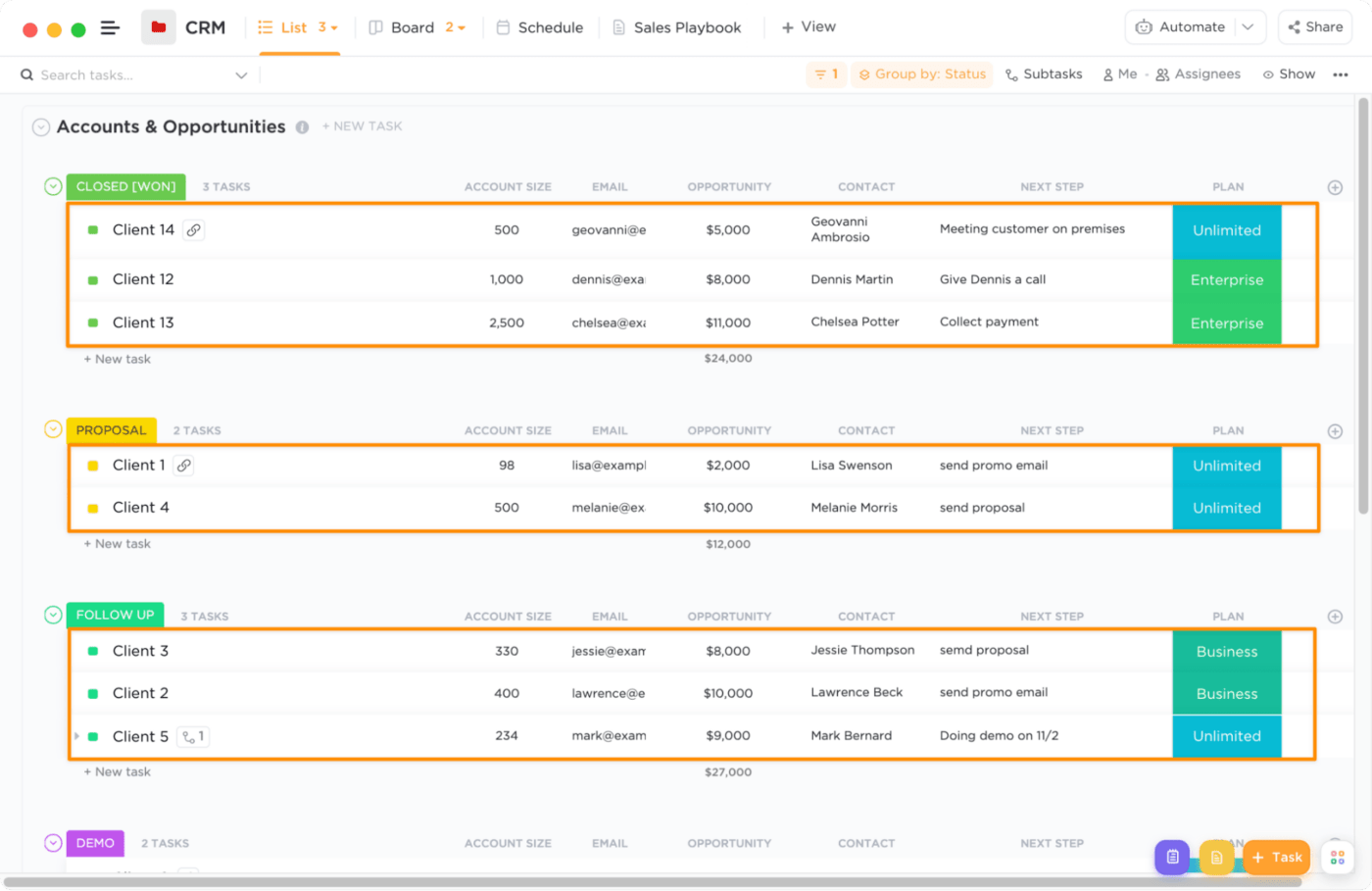
أنشئ إدارة علاقات العملاء المخصصة لعملك باستخدام قوالب ClickUp القابلة للتكيف إدارة علاقات العملاء من ClickUp مصمم لإدارة علاقاتك مع العملاء وتنميتها في مكان واحد. يحتفظ بسجل لتفاعلات العملاء مثل:
- بيانات العملاء، بما في ذلك الاسم وتفاصيل الاتصال ومرحلة التواصل
- تفاعلات العملاء ونقاط الاتصال، وقنوات الاتصال المفضلة لديهم
- الفِرق المشاركة ورحلة العميل في مسار المبيعات
إذا كان فريقك الذي يتعامل مع العميل موجوداً بالفعل على ClickUp، يمكنك مشاركة هذا المثيل مع الموظفين الجدد لإطلاعهم على آخر المستجدات حول رحلة العميل وإتاحته للفرق الأخرى التي تحتاج إليه.
نوصي باستخدام إدارة علاقات العملاء في ClickUp لأنه يجمع بين إدارة علاقات العملاء مع إدارة المشاريع . لماذا؟
يساعد استخدام إدارة علاقات العملاء مع إدارة المشاريع في إدارة بيانات مشروعك (تخطيط موارد المؤسسة والميزانية والتسليمات) وبيانات العملاء في منصة مركزية حتى لا تضيع الوقت في التبديل بين التطبيقات.
2. الاستفادة من البيانات لتخصيص اتصالاتك
إذا وضعت نفسك مكان عملائك، فستعرف أنهم لا يحبون تلقي رسائل نصية أو رسائل بريد إلكتروني أو مواد تسويقية عامة. فهم يفضلون المحتوى المخصص لاحتياجاتهم.
نظرًا لأنك تقوم بالفعل بتتبع محادثات وبيانات العملاء في حل إدارة التواصل مع العملاء، فلماذا لا تستخدم هذه البيانات لمنح عملائك تجربة لا تُنسى؟ ⭐
استخدم بيانات العملاء لتخصيص التفاعلات الرقمية مثل:
- استبيانات العملاء
- خصومات/عروض للاحتفال بأعياد ميلاد العملاء/مناسبات الذكرى السنوية وغيرها من المناسبات الهامة
- المراسلة عبر قنوات التواصل الاجتماعي
- إرسال الإشعارات أو رسائل البريد الإلكتروني بناءً على رحلة العميل على الموقع الإلكتروني
عادةً ما يتطلب هذا المستوى من التخصيص الكثير من العمل. ومع ذلك، مع التواصل التلقائي مع العملاء باستخدام تقنيات إدارة التواصل مع العملاء و استراتيجية قوية لإدارة علاقات العملاء ، يمكنك تخصيص هذه التفاعلات للعملاء على نطاق واسع.
3. ضع خطة تواصل مع العملاء
تتمثل إحدى الفوائد الرئيسية لاستخدام أدوات التواصل الآلي مع العملاء في تقليل فرص سوء التواصل حيث أن جميع الفرق متناسقة وسير العمل والقوالب محددة مسبقًا.
يؤدي التتبع اليدوي لجميع نقاط الاتصال والرسائل والتفاعلات إلى حدوث أخطاء.
وهنا يأتي دور النهج الموحد للمساعدة. A خطة التواصل مع العملاء تجعل استراتيجية التواصل مع العملاء مركزية بحيث يمكنك:
- رسم خريطة لرحلة العميل وإنشاء تفاعلات مستهدفة
- تتبع محادثات العملاء الهادفة وإعداد رسائل المتابعة
- التنسيق مع فريقك والأقسام الأخرى للحصول على تجربة عملاء متسقة عبر جميع نقاط الاتصال
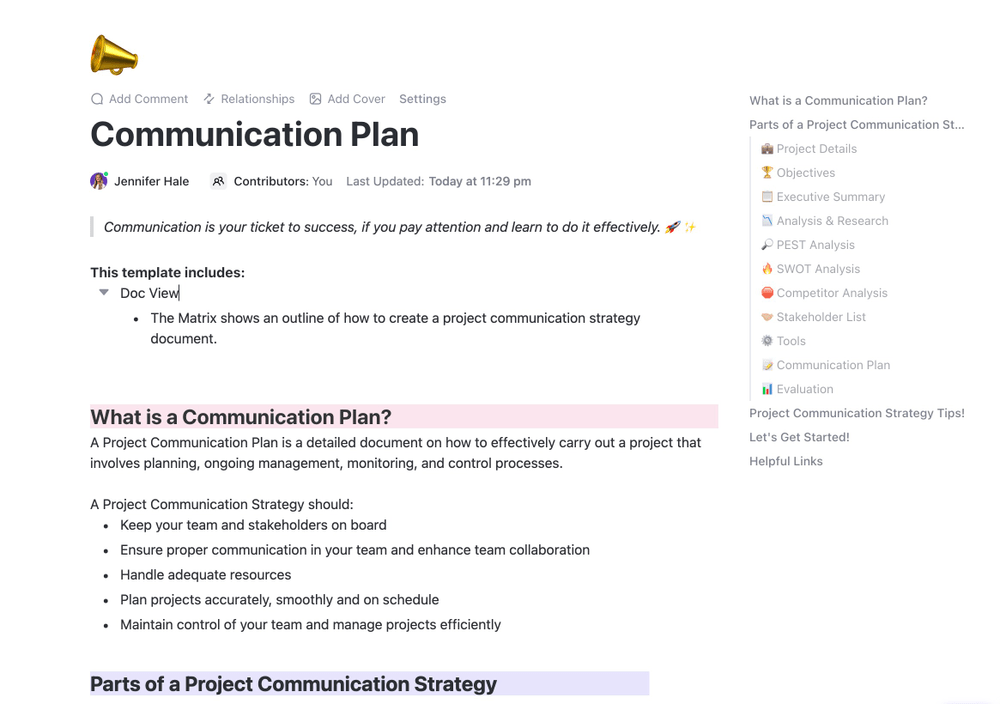
استخدم قالب خطة التواصل ClickUp لإنشاء خارطة طريق لعملية تواصل سلسة بين الفريق والعملاء
سواء كنت مالك شركة صغيرة أو قائدًا في مجال تجربة العملاء تقود شركة فريق خدمة عملاء ، فإن استراتيجية التواصل مع العملاء تغير قواعد اللعبة عند تقديم خدمة استثنائية في كل مرة.
كيف يمكنك إنشاء خطة تواصل مع العملاء؟
الخطوة 1: حدد أهدافك حتى تتمكن من تصميم اتصالاتك وفقًا لذلك.
يمكن أن تكون زيادة ولاء العملاء ورضاهم أو تحسين الاحتفاظ بهم أو زيادة المبيعات.
الخطوة 2: حدد جمهورك المستهدف بناءً على التركيبة السكانية والاهتمامات وتاريخ الشراء.
على سبيل المثال، باستخدام الحقول المخصصة في ClickUp، قم بتصنيف العملاء وتقسيمهم لإنشاء اتصالات مخصصة.
الخطوة 3: اختر قنوات التواصل الأكثر فعالية لعملائك.
نوصي باختيار مزيج من قناتين أو ثلاث قنوات تتماشى مع أهداف التواصل الخاصة بك وتفضيلات عملائك.
على سبيل المثال، بالنسبة لعلامتك التجارية الإلكترونية التي تبيع منتجات مكياج مستدامة، سيكون البريد الإلكتروني وقنوات التواصل الاجتماعي والرسائل داخل التطبيق مزيجاً جيداً.
استخدم خاصية ClickUp عرض التقويم لجدولة وتخطيط التواصل مع العملاء عبر مختلف القنوات. 🗓️
الخطوة 4: نظّم أنشطة التواصل الخاصة بك باستخدام تقويم المحتوى.
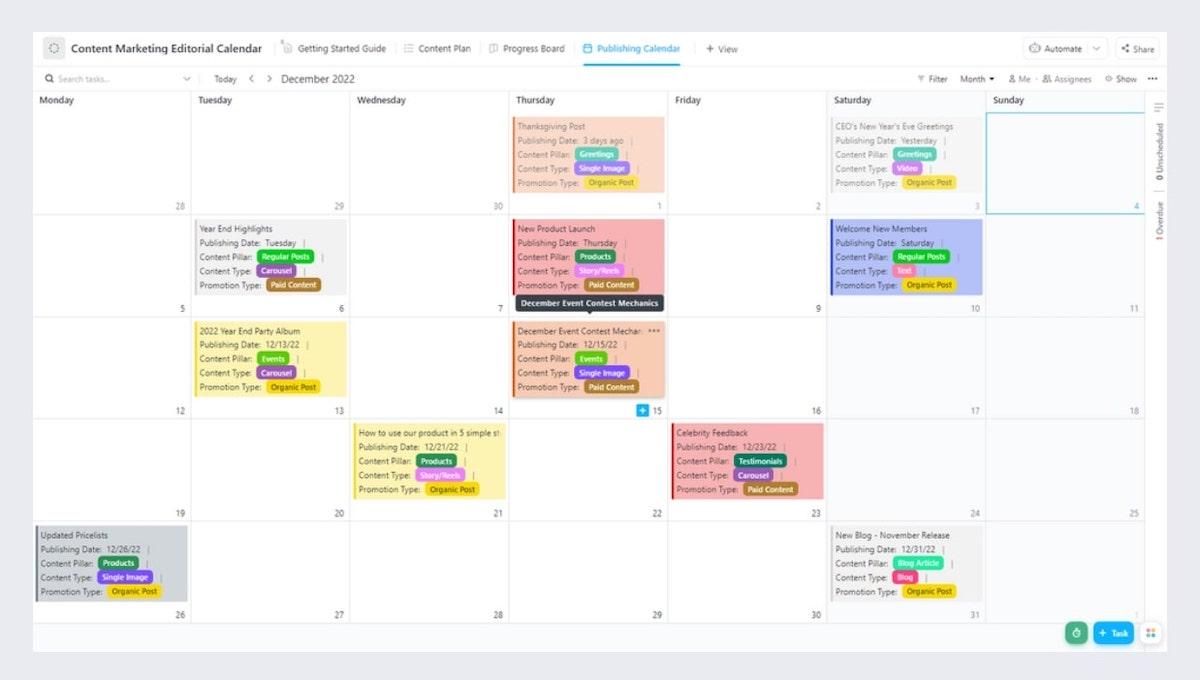
شاهد في لمحة سريعة كيف يبدو جدولك الزمني القادم للمحتوى مع قالب تقويم تسويق المحتوى من ClickUp
جهّز خريطة طريق بنوع المحتوى الذي ستتم مشاركته وقناة الاتصال والوقت المحدد والبيانات لكل رسالة.
إن مفتاح التفاعلات الرقمية الناجحة هو التفاعل مع عملائك بانتظام بمعلومات قيّمة.
ClickUp's لوحات المعلومات لديك تقويم مرئي حيث يمكنك تتبع ومراقبة اتصالات العملاء.
4. التركيز على توفير تجربة استثنائية للعملاء ذوي القيمة العالية
استخدم إدارة التواصل مع العملاء لتحديد ورعاية العملاء المنتظمين الذين يساهمون بشكل كبير في إيراداتك.
أرسل الاتصالات الصادرة ذات الصلة إلى هذه الشريحة من العملاء بناءً على احتياجاتهم وتفضيلاتهم الفردية.
ركز على تقديم خدمة استثنائية وتجارب متسقة. إليك كيفية القيام بذلك:
- التواصل بانتظام من خلال رسائل البريد الإلكتروني والمكالمات وعلى قنواتهم المفضلة. اطلب تعليقاتهم، ووفر لهم إمكانية الوصول المبكر إلى المنتجات الجديدة وعالج مخاوفهم
- تقديم مزايا حصرية تقديراً لولائهم في شكل خصومات خاصة وبناءً على سجل مشترياتهم
- قدم لهم المساعدة الاستباقية حتى قبل أن يطلبوا المساعدة
5. أتمتة سير عملك
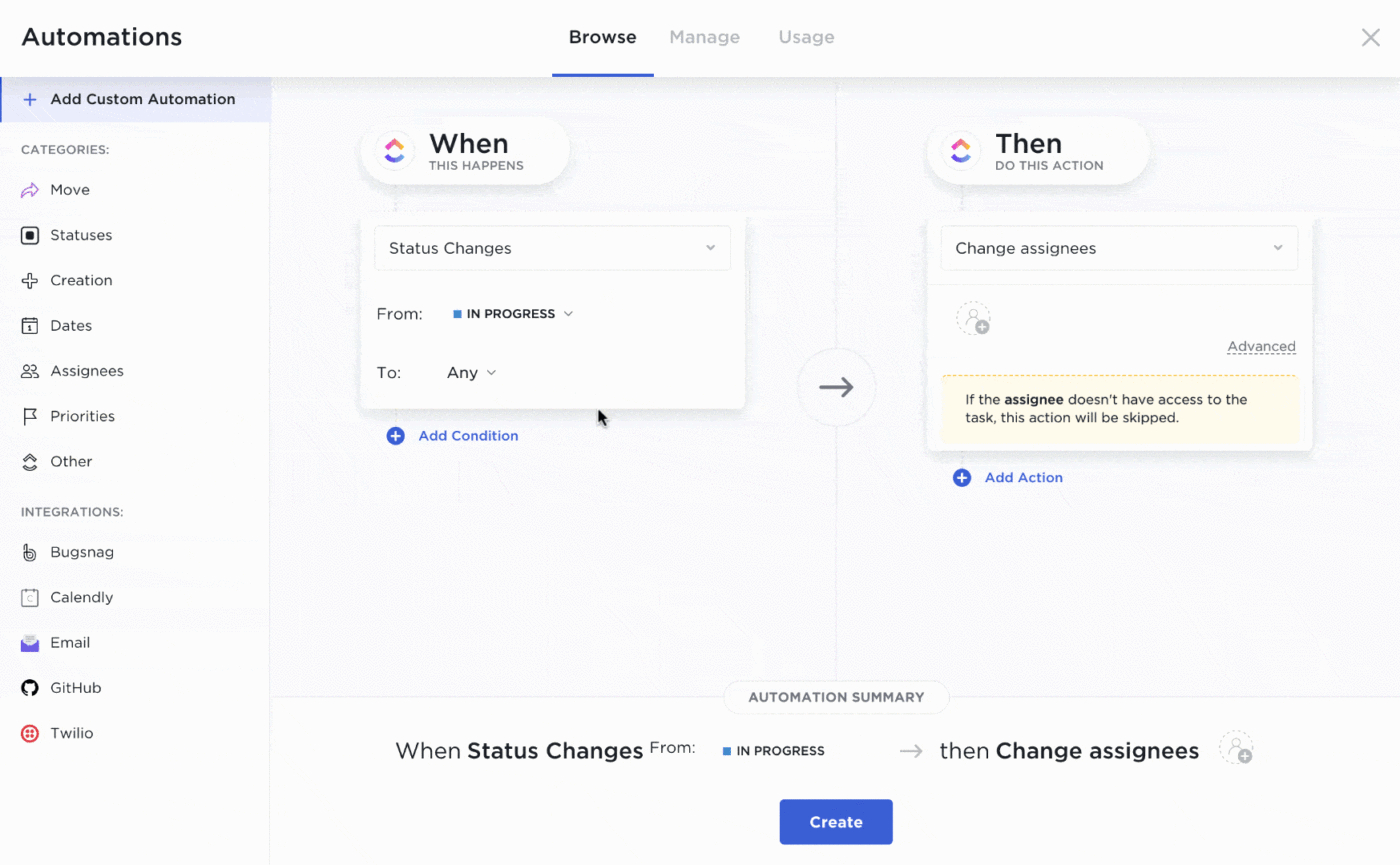
استخدم وصفات الأتمتة المُنشأة مسبقًا في ClickUp أو قم بتخصيصها بناءً على احتياجاتك حتى يتمكن فريقك من التركيز على ما هو أكثر أهمية
عندما ينتقل فريق دعم العملاء لديك من إدارة التواصل مع العملاء عبر جداول البيانات إلى استخدام حلول إدارة التواصل مع العملاء، فكّر في أتمتة مهام سير العمل الخاصة بك لمهام مثل إدارة العملاء المحتملين وإدارة دورة الحياة والتسويق عبر البريد الإلكتروني وإعداد العملاء.
باستخدام أتمتة سير العمل، يمكنك تعيين الحقول المخصصة بناءً على شرائح العملاء أو أنواع المشكلات. يمكن لمديري الدعم تعيين مهام لكل مرحلة من مراحل خط الأنابيب وتشغيل تحديثات الحالة بناءً على الأنشطة.
يمكن لسير العمل توجيه سير العمل تلقائيًا اتصالات العميل والمهام وحالة المشروع من خلال نظام إدارة علاقات العملاء دون الحاجة إلى إدخال يدوي من الفريق. ستشكرك فرقك على التخلص من العمل الشاق. 🙏
من ناحية أخرى، يمكن لفريق التسويق الخاص بك إنشاء مواد تسويقية مخصصة للعملاء المحتملين بناءً على إجراءات العميل المحتمل وحتى للعملاء الحاليين والجدد. استخدم قوالب التواصل لكل مرحلة من مراحل دورة حياة العميل: لا حدود لما يمكن تحقيقه. 🪂
6. المتابعة المنتظمة مع عملائك
لن تعتبر شخصًا ما صديقًا لك إذا كنت لا تسمع منه إلا من حين لآخر، أليس كذلك؟ 🤔
وبالمثل، ابقَ مع عملائك طوال الرحلة، وليس فقط عند حدوث عملية بيع. تتضمن إدارة علاقات العملاء التفاعل مع العملاء بشكل منتظم، ليس فقط عند الإبلاغ عن مشكلة، ولكن أكثر من ذلك عندما يكون كل شيء على ما يرام. 🤝
بعض القنوات غير التطفلية للتفاعلات المنتظمة هي:
- نماذج استبيان ما بعد الشراء عبر البريد الإلكتروني
- مراقبة المحادثات على قنوات التواصل الاجتماعي
- إشعارات داخل التطبيق بمجرد تسليم المنتج إلى العميل
وبدلاً من ذلك، استخدم التواصل الآلي مع العملاء عبر رسائل المتابعة وفق جدول زمني محدد مسبقاً.

إدارة العميل في ClickUp
أن تكون استباقيًا من خلال عمليات التحقق المتكررة و إدارة العملاء يساعدك على اكتشاف إشارات الدخان ومعالجتها في وقت مبكر.
إحدى طرق القيام بذلك هي استخدام النقر فوق النماذج التي تلتقط الملاحظات وتوجهها إلى الفريق المناسب.
استخدم الخرائط الذهنية ل ClickUp لرسم الروابط بين المهام والأفكار والملاحظات وتطوير الحلول ذات الصلة لمعالجة المشكلات.
7. منح العملاء خيارات الخدمة الذاتية
تتيح الخدمة الذاتية للعملاء مساعدة أنفسهم بأنفسهم، وغالبًا ما يكون العملاء المكتفون ذاتيًا هم الأكثر سعادة. ومن هنا يأتي القول المأثور "أفضل التواصل هو عدم التواصل".
تتيح خيارات الخدمة الذاتية لعملائك إكمال المهام البسيطة بشكل مستقل. حتى عندما يكون لديك إدارة تواصل مع العملاء، قدم لعملائك تعليم الخدمة الذاتية في شكل:
- الأسئلة الشائعة
- البرامج التعليمية
- أدلة إرشادية
- قاعدة المعرفة
تتبّع تفاعلات العملاء لفهم نقاط ضعفهم وإنشاء محتوى يعالج مشاكلهم ويحلها.
8. تدريب فريق الدعم الخاص بك لتقديم أفضل تجربة للعملاء
لن يكون تواصلك مع العملاء فعالاً إلا عند ممارسته في جميع أنحاء المؤسسة.
يجب تدريب كل فريق على تنفيذ التواصل الواضح من دعم العملاء والمنتج والتسويق إلى إدارة الحسابات.
هناك جزءان لتدريب الفرق وتمكينها,
- التواصل الداخلي والخارجي
- التقنيات المتخصصة، بما في ذلك إدارة علاقات العملاء، وحلول إدارة التواصل مع العملاء، وما إلى ذلك.
تتضمن بعض استراتيجيات التدريب على التواصل مع العملاء ما يلي:
- لعب الأدوار: يمكن لأعضاء الفريق الذين يواجهون العملاء أن يتناوبوا على العمل من خلال موقف واقعي، مثل التعامل مع عميل غاضب أو عميل لديه ملاحظات على منتجاتك
- الطريقة الأخيرة: تدريب موظفيك على استخدام طريقة الاستماع والإقرار والحل والشكر (LAST) خطوة بخطوة عند التعامل مع العملاء غير الراضين
استثمر في تدريب فريقك على كيفية استخدام أحدث التقنيات. على سبيل المثال، يمكن أن تستفيد المبيعات والتسويق من تعلم تقنيات إدارة علاقات العملاء.
يمكن أن يستفيد فريق الدعم من تعلم كيفية استخدام حلول إدارة التواصل مع العملاء، وإعداد عملية إدارة علاقات العملاء واستخدام برنامج مكتب المساعدة و برنامج الاحتفاظ بالعملاء لحل التذاكر بسرعة.
نصيحة احترافية: عزز ثقافة التعلم المستمر من خلال ورش العمل وجلسات تبادل المعرفة حيث يمكن لأعضاء فريقك مشاركة قصص النجاح المتعلقة بإدارة التواصل مع العملاء.
9. خطة تواصل داخلية
التغيير يبدأ من الداخل. هل تريد بناء تواصل فعال مع العملاء؟ ابدأ بإتقان التواصل الداخلي.
خطة تواصل داخلية قوية حيث يمكن للفرق الاعتماد على بعضها البعض للحصول على الدعم عبر جميع نقاط الاتصال. 🦸
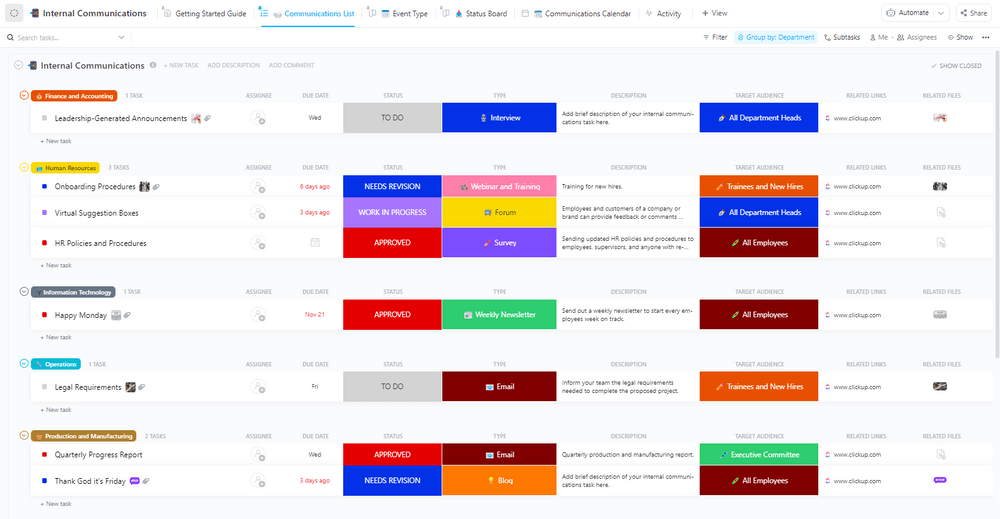
استخدم نموذج ClickUp للاتصالات الداخلية للإعلان عن الأحداث أو التغييرات لموظفيك
تعتبر نقطة البداية الجيدة لإبقاء الجميع على نفس الصفحة هي وجود نموذج الاتصالات الداخلية يمكن للمدراء وقادة الفرق إعداده. يجب أن يحتوي على:
- حالات مخصصة مثل معتمد، ومنشور، ومجدول لتتبع تقدم الاتصالات الداخلية
- حقول مخصصة لحفظ المعلومات الحيوية حول كل اتصال وتصورها
- طرق عرض مخصصة للحفاظ على إمكانية الوصول إلى جميع الاتصالات الداخلية وتنظيمها
- إدارة المشروع مع إمكانيات تتبع الوقت والتبعيات
10. قياس المقاييس الصحيحة
شيء واحد هو أن تعتقد أنك تقوم بعمل جيد. لكنك تحتاج إلى مقاييس قابلة للقياس الكمي لفهم ما إذا كانت إدارة اتصالات العملاء لديك تؤتي ثمارها.
في البداية، مقاييس العملاء التي يجب أن تبدأ بتتبعها هي
- صافي نقاط المروجين (NPS)
- معدل تذبذب العملاء
- وقت الاستجابة الأولى (FTR)
- معدل الاحتفاظ بالعملاء
- قيمة عمر العميل (LTV)
- متوسط وقت حل المشكلات (ART)
- درجة رضا العملاء (CSAT)
تتبع هذه المقاييس يدويًا أو باستخدام أدوات خدمة العملاء .
اجمع بين الملاحظات النوعية من متابعات العملاء والبيانات الثابتة لفهم أفضل لمدى نجاحك في تحقيق ولاء العملاء. ♣️
إدارة التواصل مع العملاء (CCM) مقابل إدارة علاقات العملاء (CRM)
في أغلب الأحيان، يجد المتخصصون في مجال الأعمال أن مفهومي إدارة علاقات العملاء وإدارة علاقات العملاء متداخلان. على الرغم من أهمية إدارة التواصل مع العملاء وإدارة علاقات العملاء بالنسبة لأعمالك، إلا أنهما يخدمان أغراضًا مختلفة. يسلط الجدول أدناه الضوء على الاختلافات بناءً على معايير مختلفة.
| معايير | إدارة علاقات العملاء | إدارة علاقات العملاء | ||
|---|---|---|---|---|
| التركيز الأساسي | يدعم تفاعلات العملاء عبر نقاط اتصال متعددة باستخدام مجموعة متنوعة من الأدوات. | تخزين وإدارة تفاعلات العملاء من خلال تحليل البيانات. | ||
| الميزات | إدارة المحتوى، والتحليلات، والتسليم متعدد القنوات، والتعاون في التصميم، والمستندات التفاعلية. | إدارة خط الأنابيب، وإدارة العملاء المحتملين، وأتمتة التسويق، والتحليلات وإعداد التقارير، وإدارة جهات الاتصال | ||
| حالات الاستخدام | توزيع المواد الترويجية والتسويقية | أتمتة الامتثال التنظيمي | تتبع وإدارة العملاء المحتملين للمبيعات وخطوط الإنتاج | تقسيم العملاء لأتمتة التسويق |
| الفرق التي تستخدمه | التسويق والمبيعات والمنتجات وخدمة العملاء | المبيعات والتسويق وخدمة العملاء |
حسِّن إدارة اتصالات العملاء لديك باستخدام ClickUp
ClickUp عبارة عن منصة شاملة لإدارة اتصالات العملاء. يمكنك تصور خط الأنابيب الخاص بك، وتبسيط سير عمل اتصالات العملاء، والتعاون مع فرق متعددة الوظائف.

اطلع على أكثر من 15 طريقة عرض في ClickUp لتخصيص سير عملك وفقًا لاحتياجاتك
مع ClickUp CRM يمكن لفرق خدمة العملاء لديك:
- عرض علاقات العملاء في لمحة سريعة مع أكثر من 10 طرق عرض مثل لوحة كانبان، والقوائم، وعرض الجدول
- تصور جميع بياناتك للحصول على رؤى العملاء، مثل قيمة عمر العميل، ومتوسط قيمة الطلب، والمزيد
- اجعل التواصل مركزياً من خلال دمج ClickUp مع البريد الإلكتروني. بهذه الطريقة، يمكن للفرق التعاون في الصفقات وإدارة العملاءوإرسال التحديثات وإعداد العملاء عبر مركز واحد
- إنشاءقاعدة بيانات العملاء لتخزين وتحليل جهات الاتصال والعملاء والصفقات وإضافة روابط بين المهام والمستندات لتتبع العمل
- أتمتة عمليات التسليم، وتشغيل تحديثات الحالة بناءً على النشاط وتعيين المهام لكل مرحلة من مراحل العمل
تعمل تقنيات إدارة التواصل مع العملاء الصحيحة على تبسيط إدارة التواصل مع العملاء
إذا كنت ترغب في تحسين تجربة عملاء علامتك التجارية لكسب ولاء عملائك، فإن استراتيجية إدارة اتصالات العملاء القوية تمنحك ميزة على منافسيك. 💰
أضف أدوات وتقنيات إدارة التواصل مع العملاء إلى المزيج لأتمتة سير عمل العملاء وتفاعلاتهم مع إدارة علاقات العملاء من ClickUp.
إنه استثمار سيبقي عملاءك سعداء وسيجعلهم يعودون إليك مرة أخرى.
اشترك في إدارة علاقات العملاء في ClickUp
- مجاني للأبد

